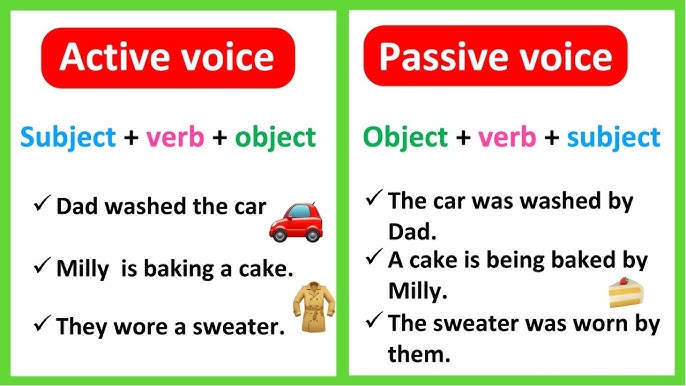Active and Passive Voice Exercises with Answers (Learn Easily!)
Understanding how active and passive voice works is crucial in mastering English grammar. Whether you’re a student preparing for exams or someone trying to polish your writing, this article will help you get a firm grip on this topic through step-by-step exercises and answers.
📘 What is Active and Passive Voice?
In English grammar, the voice of a sentence indicates whether the subject is doing the action (active) or receiving it (passive).
- ✅ Active Voice: The subject does the action.
Example: She writes a letter. - ✅ Passive Voice: The subject receives the action.
Example: A letter is written by her.
Understanding the verb’s tense and structure is key to converting between the two.
🧠 Active and Passive Voice Exercise 1: Identify the Voice
Go through the following sentences and identify whether the voice is active or passive.
- Shreya Ghoshal sings beautiful songs.
- The Sun sets in the West.
- The boy was being beaten by his teacher.
- Bucky is helped by Steve.
- The carpenter is building the desk.
- The woodcutter cut down the tree.
- The man dropped his axe into the river.
- The bird was shot by the naughty boy.
- The bag was found by me.
- Natasha lost the money.
- The farmer will plough the field.
- The work will be finished by the workers in a day.
- The enemy has entered the war zone.
- Who sang the song?
- The children teased the animals.
✅ Answers:
- Active
- Active
- Passive
- Passive
- Active
- Active
- Active
- Passive
- Passive
- Active
- Active
- Passive
- Active
- Active
- Active
💡 Tip: Passive voice often includes words like “was,” “is,” “being,” “by” and focuses on the object of the action.
✍️ Active to Passive Voice Exercise
Now, try converting these active voice sentences into passive voice.
🔄 Change Active to Passive Voice
- The dog chased the cat.
- The dog bit the boy.
- The peon rang the bell.
- Ram played hockey.
- Miss Mary teaches us English.
- Raj caught the ball.
- Children like sweets.
- Rita will take a photograph.
- Who taught you this poem?
- The police arrested the smuggler.
- Shiva was flying a kite.
- The hunter shot the deer.
- The lion attacked the zebra.
- Virat threw the ball.
- Everyone loves Zara.
- My sister has drawn this portrait.
- The people were helping the wounded woman.
- Sam had taken the medicines.
- The player is taking extra time.
- The cat ate the fish.
✅ Answers:
- The cat was chased by the dog.
- The boy was bitten by the dog.
- The bell was rung by the peon.
- Hockey was played by Ram.
- English is taught to us by Miss Mary.
- The ball was caught by Raj.
- Sweets are liked by children.
- A photograph will be taken by Rita.
- By whom were you taught this poem?
- The smuggler was arrested by the police.
- A kite was being flown by Shiva.
- The deer was shot by the hunter.
- The zebra was attacked by the lion.
- The ball was thrown by Virat.
- Zara is loved by everyone.
- This portrait has been drawn by my sister.
- The wounded woman was being helped by the people.
- The medicines had been taken by Sam.
- Extra time is being taken by the player.
- The fish was eaten by the cat.
🧠 Note: Always identify the tense first. This helps decide how to change the verb while converting voice.
🙋 Frequently Asked Questions (FAQs)
Q1: What is an active and passive voice exercise?
A: These are practice sentences where you either identify the voice or convert one to another to strengthen your grammar understanding.
Q2: How do I convert passive voice to active?
A:
- Identify the subject, verb, and object.
- Make the object of the passive sentence the subject.
- Change the verb accordingly.
- Remove “by” where applicable.
Example:
Passive: The letter was written by her.
Active: She wrote the letter.
📌 Final Thoughts
Practicing active and passive voice exercises regularly can significantly improve your grammar and writing skills. This guide offers:
- A clear explanation of the concept
- Identification exercises
- Conversion practice with answers
- Easy-to-follow tips
- Use this as your go-to worksheet whenever you want to polish your voice transformation skills!
Roman Numerals
Roman numerals are the classical numeric system using the Latin letters I, V, X, L, C, D, M to represent values via additive and subtractive rules (e.g., IV = 4, IX = 9). Commonly seen on clock faces, monarchs’ names, films, and monuments, they lend elegance and formality that Arabic numerals lack. Though limited for arithmetic and very large numbers, Roman numerals persist in modern design, branding, legal documents, and digital typography. Their timeless aesthetic and cultural prestige help them stand out in contexts where visual impact matters.
Help the Poor Change into Passive Voice
Various organizations and individuals often help the poor by dedicating their time and resources to improving their living conditions. Through community initiatives, food and shelter are provided to those in need. They collect donations to support these efforts, ensuring that assistance reaches those who need it most. By working together, society can play a vital role in changing lives and lifting the impoverished from their circumstances.





